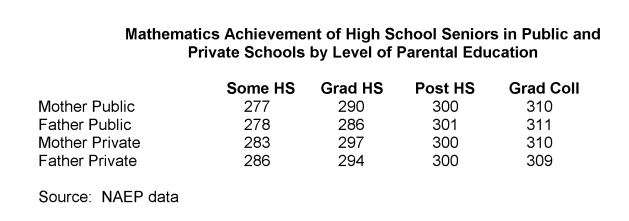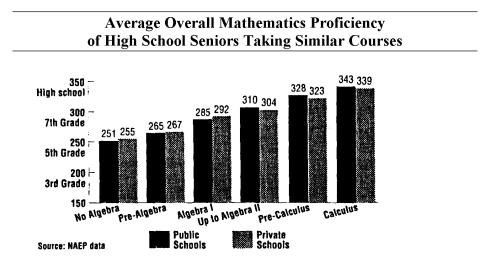Right now, members of the Bush administration are stumping the country saying that the best way for us to meet the national education goals is to use public funds to send kids to private schools. They argue that private schools take students just like the ones in public schools and do a much better job with them. But as I said last week, the results of the recent National Assessment of Educational Progress (NAEP) math exams tell a different story.
On average, NAEP results show, private school students score only slightly higher than kids from public schools. This is amazing because youngsters in private schools are a far more advantaged group, so they should be leaving public school students behind in the dust. Just as damaging to the claims of private school superiority is the fact that, when you match public and private school students who take similar courses, they get about the same scores.
It's a myth that private schools take in the same kinds of youngsters as public schools. For one thing, NAEP data show that nearly twice as many parents of public school students are school dropouts -- and that 50 percent more private school parents are college graduates. Public schools also have about three times as many students whose families have incomes under $15,000 as private schools do. At the other end of the scale. over three times as many private school students come from families with incomes of $50,000 or above as kids from public schools.
Since parental education and family income are both associated with student achievement, it's small wonder that, when you look only at average scores, private school students seem to outperform youngsters from public schools. But look at what happens when you compare the NAEP scores of high school seniors whose parents have similar education levels.

The children of high school dropouts score about the same, whether they go to public or private schools-and the same is true for the children of college graduates.
The myth of private school superiority comes totally unraveled when you compare the NAEP scores of public and private school students who have taken similar courses. The results are nearly identical, even though the public school students come from far less advantaged backgrounds. In fact, this result is evidence of a public school advantage.

Are these NAEP math results a fluke? Not at all. In 1988, Chester E. Finn, Jr., now an adviser to Secretary of Education Lamar Alexander and then an assistant secretary of education, confronted an audience of private school educators with unpublished NAEP scores revealing very small differences between public school scores (which he called "scandalously low") and the scores from private schools: Private schools were only about 4 points higher on reading and 6 points higher on history and literature. Finn suggested that the small advantage might have less to do with the quality of private schools than with the privileged backgrounds of private school students. His advice to his private school audience? "You need to improve faster than the public schools ifyou expect...people [to pay] an average of $6,200 a year ... to get a presumably better educational product."
Even James Coleman. the sociologist whose research is most often used to "prove" the superiority of private schools, warned in his study that "one should not make a mistake: Our estimates for the size of the private sector effects show them not to be large."
It's a big mistake to think that private schools do a better job with the same kids. They don't. If we are looking for answers to the enormous problems that plague our educational system. We won't find them by spending public money to send kids to private schools. Both sectors need dramatic improvement.
